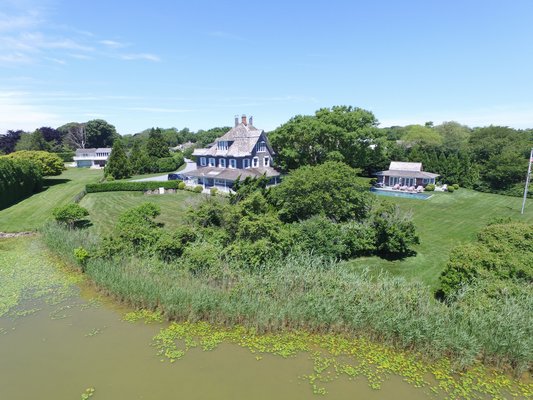
Two highly scrutinized projects in the Southampton Village historic district were approved by the Village Zoning Board of Appeals on Thursday night, October 26.
After five years of going back and forth with an application to subdivide two properties at 550 and 554 Hill Street, which includes the former Despatch Self Storage site, sitting ZBA member and property owner James Zuhusky finally got the variances required to subdivide the 2.8 acres into three lots. The vote was unanimous, with Mr. Zuhusky excluded from the count.
Members of the ZBA on Thursday also approved a wetlands permit that allows Ken Fox—a managing partner at the Stripes Group who has been instrumental in financing companies like Blue Apron, GoFundMe and Grubhub—to move one step closer to nearly doubling the size of his century-old Victorian home on Lake Agawam at 472 First Neck Lane, known as Mocomanto.
Already handicapped because of board member Mr. Zuhusky’s absence, the board voted 3-1 in favor of the permit, with Kevin Guidera, Mark Greenwald and Dan Guzewicz voting to approve the application, and Rob DeVinney voting against.
Mr. Fox plans a 1½-story addition that would increase the gross floor area of the historic house by 52 percent, from 4,717 square feet to 7,190 square feet, which is 44 percent of the maximum allowed GFA of 16,071 square feet.
The existing home sits completely in the regulated wetlands setback area. The homeowner is proposing an “L-shaped” attachment, of which only 592 square feet of the footprint would fall within the regulated wetlands setback. A special exception permit authorizing building on the regulated wetlands area was required to construct the connector to the addition.
“The proposed design respects the environment by not extending the addition to the north, east or south of the existing residence in the wetland area but seeks to cross the regulated area through the connector,” the decision read.
Over the course of three hearings, neighbors, lawyers and environmental experts all provided statements, records and studies arguing why the project should, or should not, be approved.
The board noted in its decision the prominent arguments: that standards should be applied that are applicable to zoning variances for the permit; that the Southampton Village Board of Architectural Review and Historic Preservation should review the application before the ZBA rules; that a pool house on the property that was rebuilt in 2014 after the original burned down was illegally constructed with an extended patio; that the number of rooms needs to be reviewed for accuracy; and that underground leaching pools were installed, along with a driveway, without the necessary permits.
Ultimately, all of the arguments fell short with ZBA members, with the exception of the pool house and the leaching pools. For the wetlands permit to be issued, the owner is required to restore the pool patio to its original configuration, which Mr. Fox and his team have agreed to comply with. The board is also requesting that any leaching pools within the regulated wetlands setback be removed, and, according to Southampton Village-based attorney John Bennett, who is representing Mr. Fox, that won’t be an issue—because, he said, the leaching pools don’t fall within that setback.
The applicant also proposed a 40-foot wetlands buffer, which the board requested be extended to 50 feet.
Mr. Fox’s neighbor, Joyce Giuffra, voiced her concerns about the addition and the construction of the connector within the regulated wetlands setback. Now that it’s been approved by the ZBA, she said she is concerned that it will set a new precedent going forward.
“The ZBA majority ignored the strong opposition,” Ms. Giuffra said in an email, naming the Peconic Baykeeper, the Group for the East End, the Southampton Association and 1,000 signers of a petition, all of whom spoke against the project. “We’re hopeful that the Architectural Review Board will now take a very hard look at this massive addition, which will increase Mocomanto’s footprint by 175 percent.
“It would be tragic for our village if historic homes around Lake Agawam are turned into McMansions,” she added.
Ms. Giuffra said the addition would be right next to her children’s bedrooms, and that she is concerned about the increased noise and traffic on their small shared driveway.
As to the Despatch property, Mr. Zuhusky’s variances allow a subdivision creating three parcels that cover a total of 2.8 acres on a property that currently contains two houses as well as Despatch Self Storage—but a request to build guest homes on two of the properties was denied.
Mr. Zuhusky plans one half-acre lot and a pair of lots that would be about 1.1 acres each. A variance was required from the ZBA because the properties are in two separate zoning districts, requiring 1-acre and 3-acre residential lots.
Board members voted to approve the variances on the condition that Mr. Zuhusky use innovative alternative wastewater treatment systems approved by the Suffolk County Department of Health Services for each property. Mr. Zuhusky also is required to have the nonconforming buildings on the property demolished.
“It is indisputable that the nonconforming industrial storage/warehouse use and the long, narrow nonconforming lots are incompatible with the current residentially zoned neighborhood,” the decision read. It went on to say that what was being proposed was compatible with the character of the neighborhood.
The project was criticized during the application process—which began in August 2012—by neighbors because of the proposed density, as well as Mr. Zuhusky’s proposal going before a board on which he sits. The decision notes that Mr. Zuhusky recused himself from the proceedings each time the application was brought up.
“Mr. Zuhusky did not personally appear before the board, and all presentations on the matter were made by the applicant’s agents,” the decision noted.